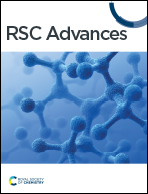Sequestration of steroidal estrogen in aqueous samples using an adsorption mechanism: a systemic scientometric review†
Abstract
Steroidal estrogens (SEs) remain one of the notable endocrine disrupting chemicals (EDCs) that pose a significant threat to the aquatic environment in this era owing to their interference with the normal metabolic functions of the human body systems. They are currently identified as emerging contaminants of water sources. The sources of SEs are either natural or synthetic active ingredients in oral contraceptive and hormonal replacement therapy drugs and enter the environment primarily from excretes in the form of active free conjugate radicals, resulting in numerous effects on organisms in aquatic habitats and humans. The removal of SEs from water sources is of great importance because of their potential adverse effects on aquatic ecosystems and human health. Adsorption techniques have gained considerable attention as effective methods for the removal of these contaminants. A systemic review and bibliometric analysis of the application of adsorption for sequestration were carried out. Metadata for publications on SE removal utilizing adsorbents were obtained from the Web of Science (WoS) from January 1, 1990, to November 5, 2022 (107 documents) and Scopus databases from January 1, 1949, to November 5, 2022 (77 documents). In total, 137 documents (134 research and 4 review articles) were used to systematically map bibliometric indicators, such as the number of articles, most prolific countries, most productive scholars, and most cited articles, confirming this to be a growing research area. The use of different adsorbents, include activated carbon graphene-based materials, single and multi-walled carbon nanotubes, biochar, zeolite, and nanocomposites. The adsorption mechanism and factors affecting the removal efficiency, such as pH, temperature, initial concentration, contact time and adsorbent properties, were investigated in this review. This review discusses the advantages and limitations of different adsorbents, including their adsorption capacities, regenerative potential, and cost-effectiveness. Recent advances and innovations in adsorption technology, such as functionalized materials and hybrid systems, have also been highlighted. Overall, the bibliographic analysis provides a comprehensive overview of the adsorption technique for the removal of SEs from other sources, serving as a valuable resource for researchers and policymakers involved in the development of efficient and sustainable strategies to mitigate the effects of these emerging contaminants.

- This article is part of the themed collection: 2023 Reviews in RSC Advances


 Please wait while we load your content...
Please wait while we load your content...